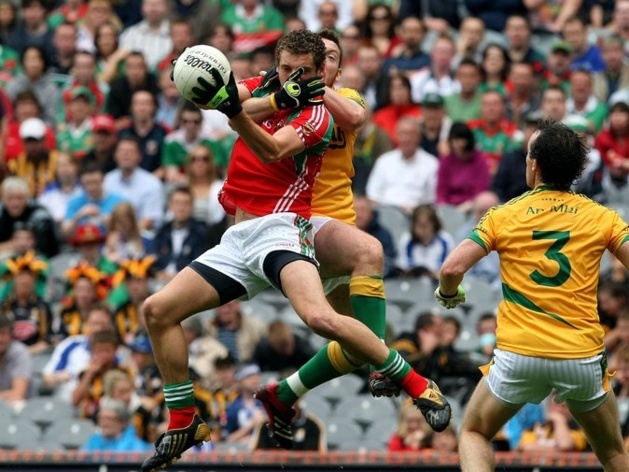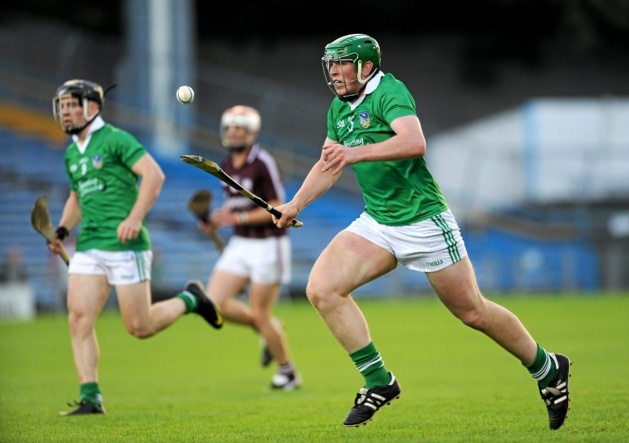
DR
The Gaelic Athletic Association (GAA) is Ireland’s main sporting association. With 2,319 clubs it represents four sports: Gaelic football, hurling, Gaelic handball and rounders. These last two being close to squash and baseball (respectively).
Gaelic football
Gaelic football, also known as Peil Ghaelach in Irish, is a very popular sport in Ireland and games are frequently sold out. Two teams counting 15 players each compete. Gaelic football is played on a rugby pitch with a ball a little heavier than a normal soccer ball. Points scored in the lower part of the goal (defended by a player) are worth 3 points whereas any point scored in the upper part will be worth 1 point. As a mix of soccer and rugby, players have to carry the ball i.e. they have to scoop the ball with their feet before being able to accomplish four steps. They then have to do a “solo”, a movement which consists in dropping the ball on your foot, kicking it and catching the ball back in your hand. The number of solos is not limited, which gives the game quite an acrobatic appearance.
Players are not allowed to pass the ball without first accomplishing a solo and cannot toss the ball: they either have to hand it to another player or to kick it. Points are scored either by kicking the ball inside the goal (lower or upper part) or by using the hand to hit the ball and send it in the upper part similarly to what volleyball players would do. In order to catch the ball back, players can tackle or shoulder their opponent. If two players are about to handpass the ball, you can also try to block the ball to catch it back. The championship opposes the 32 historical countries (set up in 1920) to which are added certain international districts such as London or New York. Gaelic football clubs are mostly found in English speaking countries and a feminine version also exists (the game lasts 60 minutes instead of 70, the players are allowed to switch the ball from one hand to another and they can scoop it with their hand).
Players are not allowed to pass the ball without first accomplishing a solo and cannot toss the ball: they either have to hand it to another player or to kick it. Points are scored either by kicking the ball inside the goal (lower or upper part) or by using the hand to hit the ball and send it in the upper part similarly to what volleyball players would do. In order to catch the ball back, players can tackle or shoulder their opponent. If two players are about to handpass the ball, you can also try to block the ball to catch it back. The championship opposes the 32 historical countries (set up in 1920) to which are added certain international districts such as London or New York. Gaelic football clubs are mostly found in English speaking countries and a feminine version also exists (the game lasts 60 minutes instead of 70, the players are allowed to switch the ball from one hand to another and they can scoop it with their hand).
Hurling

Hurling, also known as Iománaíocht in Gaelic, is the second most popular sport of the country. Its origins apparently date back to Prehistory and it would have been practiced for more than 3,000 years in Ireland. It is played on the same pitch as Gaelic football and the teams are composed of 15 hurlers each. The scoring system is similar, once again, to Gaelic football but similarities stop here. Hurling is played with a flat bat larger on the end. This bat is used to kick a ball called the “Sliotar” which is small enough to be held in your hand and light enough to be thrown easily over the pitch (“it’s heavier than a tennis ball but lighter than a soccer ball” says Finnian, a hurling fan).
Each hurler possesses one of these bats and, as in Gaelic football, the game consists in scooping the ball from the ground, hold the sliotar in one hand and running up to four steps before kicking the ball with the bat, handpassing it or doing a solo. Solos in hurling consist in putting the sliotar on the wider part of the bat and bouncing it while running. Balance needed! However, contrarily to Gaelic football, hurlers are not allowed to do more than one solo. “It’s all in the wrists” is a common saying in hurling: rather than swinging the arms as hard as possible to hit the sliotar, the wrists are important to give the sliotar its need and trajectory. A feminine version, the camogie also exists.
Each hurler possesses one of these bats and, as in Gaelic football, the game consists in scooping the ball from the ground, hold the sliotar in one hand and running up to four steps before kicking the ball with the bat, handpassing it or doing a solo. Solos in hurling consist in putting the sliotar on the wider part of the bat and bouncing it while running. Balance needed! However, contrarily to Gaelic football, hurlers are not allowed to do more than one solo. “It’s all in the wrists” is a common saying in hurling: rather than swinging the arms as hard as possible to hit the sliotar, the wrists are important to give the sliotar its need and trajectory. A feminine version, the camogie also exists.
Culture, sport and economic nationalism
Gaelic sports and the GAA have long epitomised the Irish cultural resistance against the British oppressor. During the British occupation, Gaelic sports were indeed the unique vectors by which Gaelic traditions could be kept and their role was essential for the Gaelic cultural revival. In Northern Ireland, a majority of GAA members are Catholics and since the nomination of its first patrons (Nationalist leaders Charles Stewart Parnell and Michael Davitt), it continues promoting Celtic traditions.
The sponsoring of the International Hurling Festival in Galway by Aer Lingus, one of the two national airlines and the fact this event is connected to the wider Gathering 2013 festival (a year-long cultural festival aiming at celebrating Irish culture and diaspora by inviting all Irish expatriates to come back and reinvest in Ireland) is therefore not surprising. Gaelic sports are part of a well-defined politico-cultural strategy. By inviting world teams in Ireland to participate in the festival, Ireland celebrates its millenary traditions while using these customs to secure its economic future.
The sponsoring of the International Hurling Festival in Galway by Aer Lingus, one of the two national airlines and the fact this event is connected to the wider Gathering 2013 festival (a year-long cultural festival aiming at celebrating Irish culture and diaspora by inviting all Irish expatriates to come back and reinvest in Ireland) is therefore not surprising. Gaelic sports are part of a well-defined politico-cultural strategy. By inviting world teams in Ireland to participate in the festival, Ireland celebrates its millenary traditions while using these customs to secure its economic future.






























